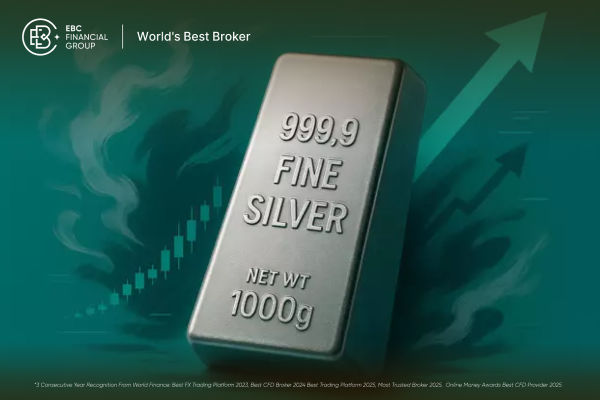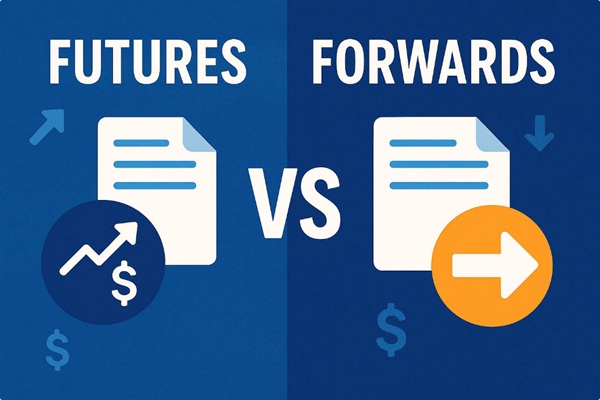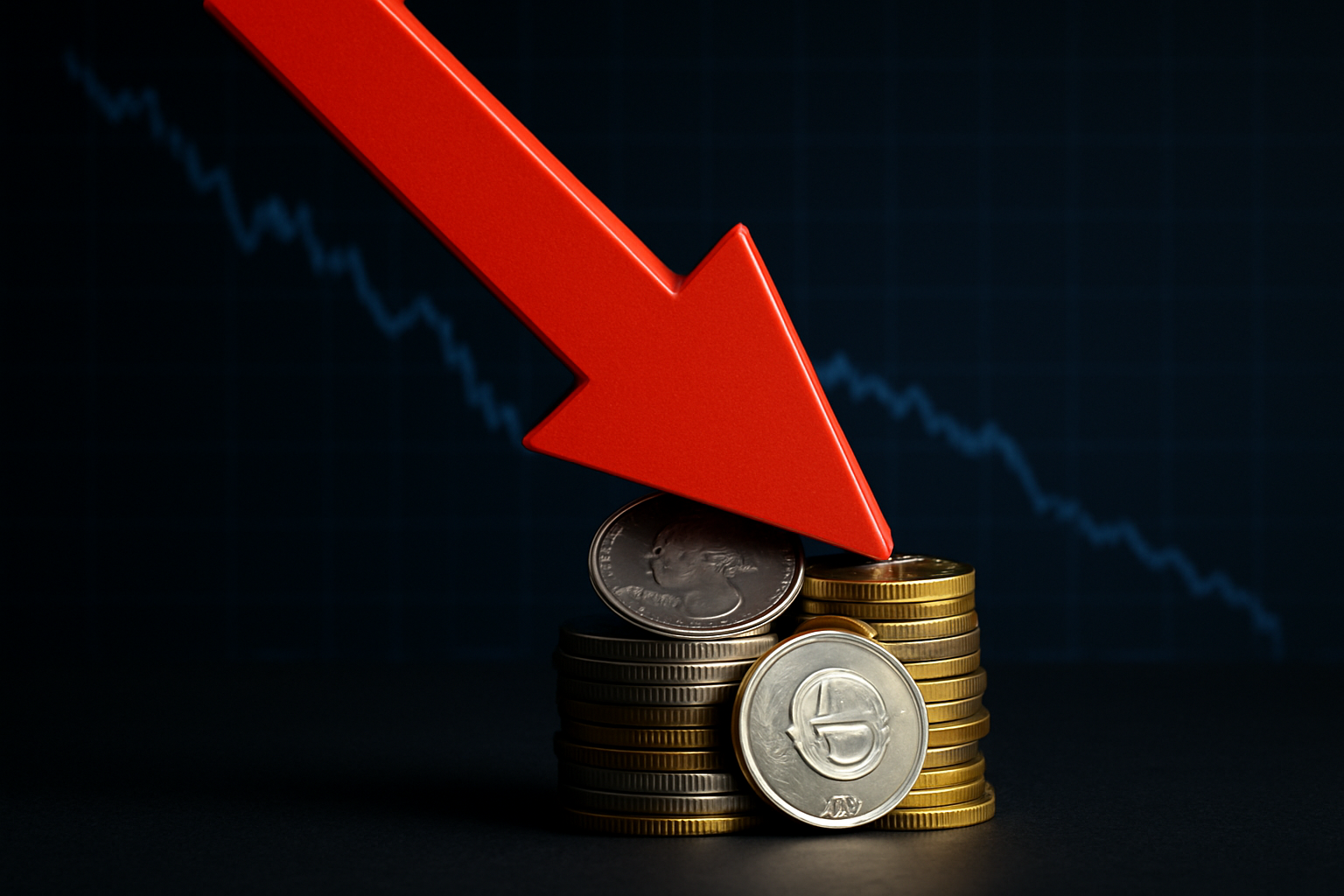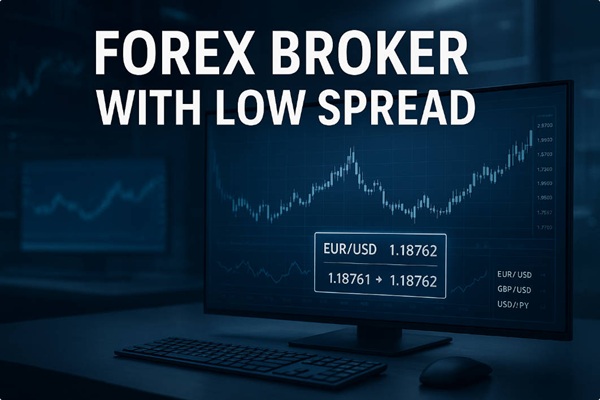Copper and platinum are flashing signals that investors cannot afford to ignore in late 2025. LME copper is trading around $10,600 per tonne, hovering within striking distance of its 2025 record high that approached $11,000, whilst exchange stocks have fallen to 137,150 tonnes—down from over 141,000 tonnes at the start of October.
Meanwhile, the World Platinum Investment Council projects platinum's third consecutive annual deficit of approximately 850,000 ounces in 2025, with mined supply expected to drop 6% year-over-year to 5.43 million ounces.
These conditions matter now because both metals are at inflection points: copper's shrinking inventories suggest any demand surge or supply shock could drive prices to fresh records, whilst platinum's persistent deficit is finally attracting investor attention after years of being overlooked.
With gold breaking records and industrial demand remaining robust, both metals offer asymmetric upside for those positioning ahead of potential squeezes.
The twin tightness reflects deeper structural shifts—copper benefiting from electrification and grid expansion in the US and India, even as China's growth moderates, whilst platinum's supply constraints and autocatalyst demand create a shortage that traditional investment flows have yet to fully recognise.
Copper at $10,600: LME Stocks Fall 4,575 Tonnes
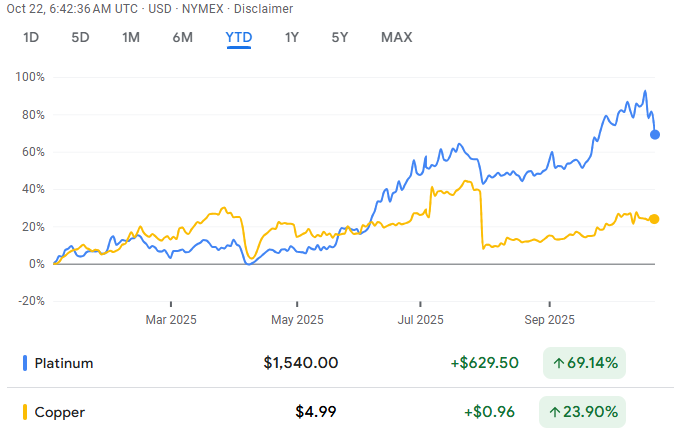
LME copper prices have maintained remarkable resilience through October 2025, with cash copper trading around $10,612 per tonne and three-month futures at $10,637 on 21 October.
This pricing sits comfortably within the metal's elevated 2025 range and only 4-5% below the record levels approached earlier this year.
| Copper Market Snapshot |
Current Data (Oct 2025) |
| LME cash price |
$10,612/tonne |
| LME 3-month price |
$10,637/tonne |
| LME stocks |
137,150 tonnes (down from 141,725 early Oct) |
| October stock decline |
4,575 tonnes |
| 2025 record high |
Approached $11,000/tonne |
| Year-to-date gain |
+13.63% |
The most striking development has been the steady drawdown in LME warehouse stocks, which have declined 4,575 tonnes during October alone. This inventory decline signals that physical demand continues to outpace available supply, creating tightness in the spot market that supports elevated prices.
Key copper demand drivers reshaping the market:
US and India are emerging as new demand leaders as China's property-driven consumption moderates.
Electrification spending across power grids, EV charging infrastructure, and renewable energy installations is driving structural demand growth.
Data centre construction boom requires massive copper input for power distribution and cooling systems.
Supply disruptions in major producing regions, including Chile, the Democratic Republic of Congo, and Indonesia creating persistent production shortfalls. [1]
Fitch Solutions' BMI recently raised its 2025 copper price forecast, citing resilient consumption and ongoing supply disruptions as justification for higher average prices extending into 2026.
The forecast upgrade reflects growing confidence that copper's fundamentals remain tight even as some analysts had anticipated price corrections earlier in the year.
Platinum Faces 850,000-Ounce Deficit in 2025
The platinum market tells an equally compelling story of structural tightness, with the World Platinum Investment Council (WPIC) projecting the metal's third consecutive annual deficit in 2025.
| Platinum Market Balance |
2025 Projection |
2024 Actual |
| Annual deficit |
850,000 ounces |
968,000 ounces |
| Mined supply |
5.43 million ounces (down 6% YoY) |
5.76 million ounces |
| Total supply |
Declining |
Constrained |
| Key constraint |
South African output |
Power/maintenance |
| Current price |
~$1,014/oz (Oct 22) |
Variable |
| Year-to-date gain |
+48.15% |
Strong rally |
Platinum's deficit stems primarily from supply-side constraints rather than explosive demand growth.
South African platinum mines, which account for the majority of global production, continue to face operational challenges, including power supply disruptions, labour issues, and ongoing maintenance requirements that limit output.
The 6% year-over-year decline in mined supply to 5.43 million ounces represents a significant tightening of available metal flowing into the market.
When combined with relatively stable demand from the autocatalyst, industrial, and jewellery sectors, this supply contraction creates a structural deficit that must be filled by either recycling or inventory drawdowns.
Platinum demand factors supporting prices:
Autocatalyst substitution from palladium to platinum in diesel and some petrol applications as manufacturers respond to price differentials
Industrial demand for platinum in chemical, petroleum refining, and electronics applications remains steady
Emerging hydrogen economy applications, particularly proton exchange membrane (PEM) fuel cells, represent potential long-term demand growth
Investment demand is showing signs of revival as the deficit narrative gains wider recognition
How Gold's Record Run Lifts Copper and Platinum
Gold's advance to record highs in October 2025 has created favourable conditions for broader precious and semi-precious metal appreciation.
When gold rallies strongly, investment capital often rotates into related metals, including platinum, palladium, and silver, seeking similar exposure with potentially better value propositions. [2]
| Metal |
Current Context |
Relationship to Gold |
2025 Performance |
Key Catalyst |
| Gold |
Record highs |
Baseline safe haven |
Strong gains |
Monetary uncertainty |
| Platinum |
~$1,014/oz |
Historically traded near parity |
+48.15% YTD |
Deficit + rotation flows |
| Copper |
$10,612/tonne |
Industrial proxy to gold |
+13.63% YTD |
Supply squeeze + demand |
Platinum appears particularly positioned to benefit from gold's strength, given its persistent physical market deficit creating fundamental support, historical price discount to gold (platinum has historically traded near parity with gold but currently sits well below), and dual identity as both an industrial metal and a store-of-value asset.
Copper, whilst not a precious metal, benefits through broader commodity rotation and increased appetite for hard assets during currency debasement concerns.
Copper vs. Platinum: Which Offers Better Value?
For investors choosing between the two metals, each presents distinct risk-reward profiles suited to different investment horizons and objectives.
| Factor |
Copper |
Platinum |
Assessment |
| Supply deficit |
Structural, multi-year |
850k oz/year, third consecutive |
Tie — both tight |
| Distance from 2025 high |
~4–5% below |
Variable positioning |
Copper (near-term) |
| Demand visibility |
Clear: EVs, grids, data centres |
Mixed: auto declining, hydrogen emerging |
Copper |
| Investment flows |
Limited dedicated ETF options |
Growing ETF interest |
Platinum |
| Upside to records |
4–5% to $11,000 |
Depends on the timeframe |
Copper (near-term) |
| YTD performance |
+13.63% |
+48.15% |
Platinum |
What Could Derail Copper and Platinum Rallies?
Despite constructive fundamentals, both metals face headwinds that could limit upside or trigger corrections. Assessing probability helps frame position sizing and risk management.
High probability risks:
China's economic slowdown is deeper than expected, particularly in the property and infrastructure sectors, reducing copper demand
US dollar strength making dollar-denominated commodities more expensive for international buyers, pressuring prices
Medium probability risks:
Recession fears in developed markets are reducing industrial demand projections below the current consensus
Platinum substitution away from diesel vehicles is accelerating faster than platinum can pivot to petrol or hydrogen applications
Speculative positioning unwinds, triggering technical sell-offs despite strong fundamentals
Low probability but high impact:
Large-scale copper mine restarts or new capacity additions are surprising to the upside, adding unexpected supply
South African platinum production is recovering more quickly than expected if the power supply stabilises and maintenance backlogs clear
Palladium substitution reverses if palladium prices decline sharply, reducing platinum autocatalyst demand
Key Data to Track: Copper Stocks and Platinum Supply

Investors should monitor specific indicators with defined timeframes to gauge whether tight markets will drive prices higher or face correction pressures.
This week (Oct 22-26, 2025):
LME copper stocks (daily updates): Watch for continuation below 135,000 tonnes signalling intensifying tightness
Shanghai copper premiums: Rising premiums indicate China demand recovery, offsetting property weakness
Platinum spot price action: Sustained moves above $1,020/oz suggest buying pressure building
This month (October 2025):
US housing starts (Oct 24 release): Proxy for copper construction demand heading into spring 2026 building season
China PMI (Oct 31 release): Leading indicator for industrial metals demand, particularly copper
Weekly LME inventory reports: Cumulative October decline already 4,575 tonnes; further draws support higher prices
This quarter (Q4 2025):
WPIC November platinum market update: Revised 2025 deficit estimate and 2026 preliminary outlook
South African platinum miner Q3 production reports: Anglo American Platinum, Sibanye Stillwater output data
Major copper miner quarterly production: Freeport-McMoRan, Codelco guidance for year-end and 2026
Price triggers to watch:
Copper: Break above $10,800/tonne targets $11,000-$11,200 zone, establishing new record territory
Copper: Fall below $10,300/tonne signals correction toward $10,000 support
Platinum: Sustained move above $1,050/oz opens path toward $1,100+ psychological resistance
Platinum: Break below $980/oz would challenge the recent rally and test $950 support
Conclusion
The confluence of copper trading near record highs with inventories at 137,150 tonnes and platinum's 850,000-ounce third consecutive deficit represents a rare alignment of tight physical markets in two strategically important metals. Whether these conditions translate to sustained price appreciation through year-end and into 2026 will depend on demand resilience, supply responses, and broader macroeconomic developments—but the structural case for both remains compelling. [3]
Disclaimer: This material is for general information purposes only and is not intended as (and should not be considered to be) financial, investment, or other advice on which reliance should be placed. No opinion given in the material constitutes a recommendation by EBC or the author that any particular investment, security, transaction, or investment strategy is suitable for any specific person.
Sources
[1] https://www.mining.com/bmi-lifts-2025-copper-forecast-on-resilient-demand-supply-disruptions/
[2] https://tradingeconomics.com/commodity/platinum
[3] https://www.nasdaq.com/articles/wpic-platinum-record-third-annual-deficit-supply-fails-meet-demand













